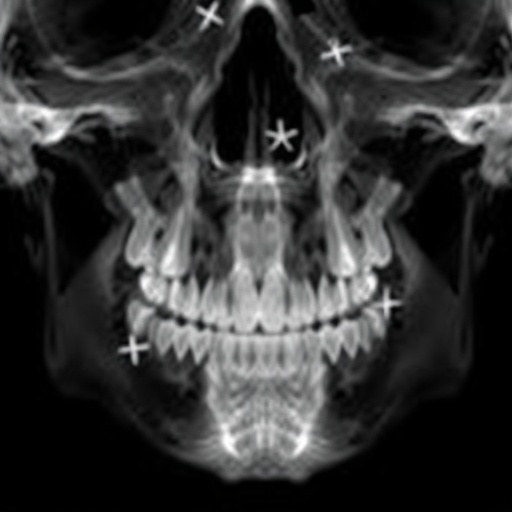In a remarkable stride toward revolutionizing orthodontic care, researchers have unveiled a cutting-edge automated diagnostic approach that harnesses the power of self-supervised learning combined with multi-attribute classification to analyze lateral cephalograms. This breakthrough promises to dramatically enhance the accuracy and efficiency of malocclusion diagnosis—a condition that affects over half the global population and significantly impacts oral health and quality of life.
Orthodontic diagnosis traditionally relies heavily on the expertise of specialists interpreting lateral cephalograms—a type of X-ray imaging that provides a detailed side view of the craniofacial structure. Despite its crucial role, the process is often time-consuming and subject to human variability. Now, leveraging sophisticated machine learning methodologies, the new framework aims to standardize and expedite diagnostic procedures while maintaining, or even surpassing, human-level accuracy.
At the heart of the new technique lies a self-supervised pre-training model constructed from multi-center datasets of lateral cephalograms sourced from diverse clinical environments. This approach enables the model to learn robust and generalized structural features without requiring extensive manual annotations, which are often a limiting factor in medical imaging AI. By tapping into the vast amounts of unlabeled data, the system attains a deeper understanding of anatomical variations across populations.
Complementing self-supervised learning is an innovative multi-attribute classification network designed to exploit inherent correlations among different orthodontic attributes. Rather than treating each diagnostic label independently, this network optimizes parameters by considering the interplay between attributes, thereby improving classification performance and yielding more holistic diagnostics that align closely with clinical reasoning.
Extensive validation of this framework was performed using both publicly available datasets and real-world clinical imaging repositories. The results are compelling—achieving an average classification accuracy of 90.02%, a best match ratio (MR) of 71.38%, and an impressively low Hamming loss (HL) of 0.0425%. These metrics underscore the model’s ability to correctly identify complex malocclusion patterns and minimize erroneous attribute predictions, which are critical in sensitive medical decision-making.
Beyond raw performance indicators, the study emphasizes the adaptability of the automated system across data collected from different centers, addressing a pervasive challenge in medical AI: the problem of domain generalization. By incorporating lateral cephalograms from varied sources during self-supervised training, the model exhibits robustness against differences in imaging protocols and patient demographics, ensuring wider applicability and reliability.
The implications of this research are far-reaching. Timely and precise malocclusion diagnosis influences treatment planning, outcome prediction, and the overall patient experience in orthodontics. Automating this process could drastically reduce clinician workload, mitigate diagnostic disparities due to human error, and accelerate treatment initiation. Such improvements can ultimately lead to better health outcomes and patient satisfaction.
Moreover, the economic impact of adopting such AI-driven methodologies cannot be overstated. Orthodontic treatments often require significant financial investment and resources. By reducing diagnostic time and errors, clinics can optimize operational efficiency, potentially lowering costs for both providers and patients. This democratization of sophisticated diagnostics aligns with broader healthcare goals focused on accessibility and value-based care.
Importantly, this study also sets the stage for further AI-driven innovations in dental and craniofacial imaging. The successful application of self-supervised learning techniques to lateral cephalograms opens pathways for similar methodologies to be employed in other imaging modalities and specialties, fostering the continued evolution of precision medicine within dentistry and beyond.
The research team behind this pioneering work includes Chang, Bai, Wang, and their colleagues, whose contributions exemplify the convergence of biomedical engineering and artificial intelligence to tackle long-standing clinical challenges. Their study, published in the esteemed journal BioMedical Engineering OnLine, details the methodology and findings, providing a comprehensive resource for future scientific inquiry and clinical translation.
Looking ahead, integrating this automated diagnostic framework into orthodontic practices will require collaboration between AI developers, clinicians, and healthcare systems to address regulatory considerations, interpretability, and user training. Nonetheless, the foundation laid by this study heralds a new era, where AI not only supports but actively enhances the capabilities of dental professionals in delivering personalized, evidence-based care.
As the integration of AI in medicine accelerates, findings like these underscore the transformative potential of combining domain knowledge with advanced computational techniques. By refining how healthcare providers understand and interpret complex anatomical data, AI-powered tools stand to redefine diagnostic precision and ultimately improve health outcomes on a global scale.
With such promising advancements, patients suffering from malocclusion may soon benefit from faster, more accurate, and accessible diagnoses, paving the way for more effective interventions and improved oral health worldwide. This synergy of technology and dentistry illustrates the profound impact emerging AI technologies continue to have across all facets of healthcare.
Subject of Research: Automated orthodontic diagnosis using self-supervised learning and multi-attribute classification on lateral cephalograms.
Article Title: Automated orthodontic diagnosis via self-supervised learning and multi-attribute classification using lateral cephalograms.
Article References:
Chang, Q., Bai, Y., Wang, S. et al. Automated orthodontic diagnosis via self-supervised learning and multi-attribute classification using lateral cephalograms. BioMed Eng OnLine 24, 9 (2025). https://doi.org/10.1186/s12938-025-01345-0
Image Credits: Scienmag.com




